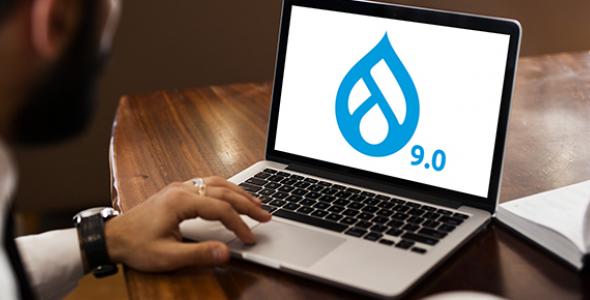Drupal 8 migration: why now is the time to upgrade
The looming Drupal 7 end-of-life – together with the news that Drupal 9 is dropping in Summer 2020 – has caused a lot of uncertainty amongst our clients and many of the brands we speak with.
So to dispel some myths and help you on your Drupal 8 migration path, here’s some sage advice from our CTO Richard Jones (who literally wrote the book on learning Drupal 8).
Start planning your Drupal 8 migration
The first thing to stress is that, even if Drupal 7 wasn’t heading into end-of-life, I would urge you to migrate to the latest version of Drupal 8.
The Drupal 8 ecosystem is really strong today, and many of the modules that you would have added on to Drupal 7 from the community are now incorporated into Drupal Core.
You might be asking why you shouldn’t just upgrade to the upcoming Drupal 9. Well, unlike Drupal 8 – which is a major platform rewrite from 7 – Drupal 9 is essentially just the next iteration of Drupal 8.
It’s important because it will drop obsolete APIs and third-party dependencies, and ensure you’re up-to-date and fully supported.
But taking advantage of those features requires you to already be on Drupal 8, because the path from 7 to 9 is far from smooth, and will cause you unnecessary complications and delays.
So the TL;DR is: don’t panic about the Drupal 9 announcement! If you’re already on track to upgrade to Drupal 8, the upcoming new version won’t make life any harder for you.
If, however, you’re still on Drupal 7, it really is time to start planning your Drupal 8 migration path.
The benefits of Drupal 8 migration
Drupal 8 is a mature platform. The open-source content management system (CMS) is stable, fully-featured, and equipped to help organisations navigate content delivery to new channels and content-consuming devices. So could it be right for your business?
- ‘API first’. Drupal founder Dries has blogged and talked a great deal about Drupal’s evolution towards becoming an API-first platform. By providing a REST API out-of-the-box, Drupal 8 puts this philosophy into practice by offering native support for both traditional web experiences and a wide range of content delivery solutions. In the race to grow and engage audiences in the right way across a growing number of customer touchpoints with different contexts, headless or decoupled content management systems will be key. By supporting API architectures, Drupal is primed for a world of content management where APIs will be relied upon to fetch the right content components and present them in the right way for individual platforms.
- The Drupal community. Drupal continues to be backed by a strong community of developers, leading agencies, and professionals. For this reason it remains ahead of the curve in my opinion. With Drupal 8 reaching maturity, the Drupal community’s focus is very much on Drupal 8 and a smooth transition into Drupal 9 ahead of anything else; emerging technologies and innovations are likely to be supported by Drupal 8 APIs ahead of earlier Drupal versions. With around 1,400+ stable Drupal 8 modules out there right now, we have a fantastic toolkit to hand.
- Flexible and scalable. Drupal 8 scales easily, from tiny sites to billion-page-view multi-platforms for enterprise customers. The combination of its API-first characteristics and the platform’s latest UX developments means that Drupal 8 can meet the needs of businesses with small but highly integrated systems, as well as those with large, complex infrastructures.
- Strong roadmap. With many new key modules coming into Drupal 8, from enhanced media management and multi-site content delivery, to game-changing UX, Drupal 8 is getting stronger all the time. The ‘Out-of-the-box Experience’ initiative aims to deliver a better first experience for Drupal newbies and provides a platform for highlighting many of the great distributions available. In the past, full-point upgrades in Drupal (from Drupal 6 to 7, for example) were painful. This has been acknowledged by the core team and we now have a semantic versioning system. The resulting small-point updates, with no backward compatibility breaks, allows innovation within Drupal 8, and also protects us in regards to a Drupal 8 to 9 upgrade at some point in the future.
The brands migrating to Drupal 8
We’ve helped many high-profile brands make the migration from Drupal 7 to 8, from Arsenal FC to Imperial War Museums, (and ourselves!). Here’s a round-up of some of our favourite Drupal 8 websites.

Arsenal.com is a great example of a global brand that’s making the most of Drupal 8’s flexibility to publish its media assets across a wide range of touchpoints. The site is able to pull in media content from players and fans via Twitter and Instagram using contributed modules and publicly-available APIs. This content can then be reused in news stories and live match coverage.
Key considerations for Drupal 8 migration
There's certainly no easy way to upgrade to Drupal 8, but today there is a much improved migration plan for anyone thinking of upgrading from Drupal 6 or 7 to Drupal 8.
You’ll first need to install a clean Drupal 8 site before migrating your site configuration and content to the new site. In other words, your existing Drupal 6 / 7 site will remains as it is.
Remember that it’s harmful to approach any website replatform as a ‘lift and shift’ exercise, and you shouldn’t expect your new Drupal 8 site to be the same as your old site.
For one thing, all the modules you think you need might not have an automatic upgrade path. As Drupal recommends, you might want to use a custom migration approach, but it’s important to remember that your focus should be on finding the cheapest and easiest ways of delivering value, rather than features.
Whatever platform you’re migrating from, you’ll need to carefully consider content architecture and how you’ll migrate content to your new platform.
Best practices for launching a Drupal 8 site
Take a minimum viable product (MVP) approach to development so that, from the get-go, you can start testing and learning about how users are interacting with your site and how it measures up against your business goals.
As part of this approach, you should focus on migrating only your primary content initially. Prioritising your content in this way is important for ensuring you dedicate more attention to the pages that are generating the most traffic.
To take advantage of Drupal’s API capabilities, and break content down into reusable components for multiple devices, you should evaluate content dependencies and the complex ways content fits together. Remember that legacy CMS systems include a lot of content via the WYSIWYG interface that can’t be read by many new channels and could hind delivery to those touchpoints.
Remember that unless your content delivers value to your readers, it’s not worth bringing over to the new platform.
Engaging a Drupal consultant
Digital platform implementations, or re-platforming exercises, are rarely straightforward, and that’s why we always recommend speaking with an experienced third party.
Drupal consulting allows you to fully understand your options and make informed decisions that support the needs of the business and your customers.
Do get in touch if reading this post prompts any questions about your own Drupal 8 migration path, or if you’re interested in how we may be able to support you.





